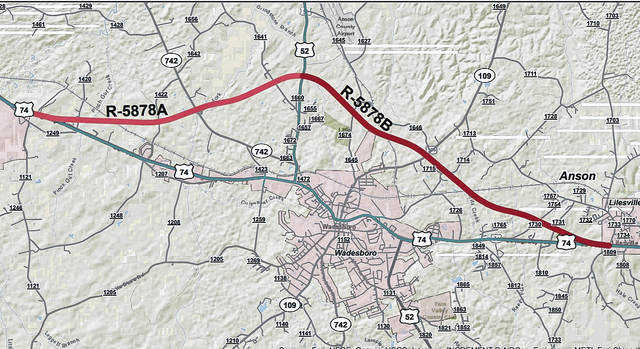WADESBORO — New bypass plans are set to move through Anson County and the town manager says there is no stopping it.
During a Wadesboro Town Council meeting on Feb. 11, Lee Snuggs, director of the Rocky River Rural Planning Organization, presented an update on the new U.S. 74 bypass that will cut through Anson County.
This bypass has been in the works for at least 10 years, according to Wadesboro Town Manager David Edwards. The overall goal is to link Charlotte to the Port of Wilmington with a trucking route to minimize the traffic between the two cities. Then in the long run, this route could extend to Asheville, but that is not the immediate focus.
Over the last decade, the Port of Wilmington has increased its capacity and infrastructure. The state hopes the port will become even more viable for overseas companies to ship to Wilmington. With a complete 74 bypass, those companies can then transfer items to the intermodal facility in Charlotte. This would be a huge asset to the state, according to Edwards.
“Right now they are not there yet,” Edwards said. “It is still cheaper for a company to bring freight in from Charleston and bring it from Charleston to Charlotte than it is from Wilmington to Charlotte, just because Charleston is linked 100% with interstate. Even though it is an hour longer drive, it is still cheaper because they don’t have to stop.”
The state’s hope is to bring Highway 74 into interstate status, making it a more cost effective way to bring freight from ships in Wilmington to Charlotte. The Wadesboro portion of the project is a top priority for NCDOT, followed by Marshville and Laurel Hill.
The Monroe Express, which opened in 2018, is part of this interstate plan. At the time, the traffic in Monroe was the biggest priority. Now, that priority has shifted to Anson. Wadesboro has the “biggest road bump” because of the traffic lights within the town. Laurel Hill only has one traffic light along the corridor and Marshville has about three.
“The Wadesboro bypass is coming,” Edwards said. “It is scheduled to be roughly … about a $150 million project. The first half, which would be the eastern half, is fully funded and the project is essentially underway, but we are still in the early planning, design and engineering stages at this point.”
The funding for the project comes from the State Transportation Improvement Program (STIP).
Although the route is not finalized, locals are already voicing concerns about the bypass. One resident spoke during the Town Council meeting on March 1. He expressed concerns that the bypass has been in the works without the public’s knowledge, as he found only one article on the topic. But because it is unlikely to stop the progress of the project, he encouraged the town to help make it as least impactful as possible on residents and business as businesses are going to suffer.
Edwards said he understands the frustration coming from Anson residents now, even though the project has been talked about for a decade.
“People will be given the opportunity to interact with the DOT,” Edwards said. “Right now it is premature to do that because there is really a lot of uncertainty about the route.
There will be a public hearing in the future, but because the route is not finalized, there is nothing to propose yet.
“This project is happening, whether we like it or not…it’s out of our hands,” Edwards said. “What we got to do is be ready and maximize our ability to benefit from the project.”
The general route of the first half, which will be built first, begins in Lilesville, just west of the elementary school. The bypass would then travel to the north and west, intersecting with Highway 52 somewhere between Anson Middle School and the airport.
The other half of the project will continue on west from the point near the middle school, rejoining Highway 74 around the school bus garage and the landfill. The funding for west side of the bypass has not been fully secured yet, according to Edwards.
This layout is not confirmed yet.
“Really it is going to look much more squiggly,” Edwards said. “They’ll go around houses, they’ll have to cross streams and bodies of water at the right angel.”
NCDOT employees are out in the community using reflective markers to help capture aerial photography. The markers help guide the photography through the proposed areas.
After this section of research is done, environmental impact studies will need to be conducted.
“Ultimately, that is what determines where the route will go,” Edwards said. “You have to look at stream crossings, any wildlife concerns that there may be, balancing the impact between natural environment versus built or man-made environment. They’re going to try really really hard not to go through anybody’s house…I can’t promise they won’t, but they’re really, really probably won’t.”
Edwards doesn’t see NCDOT bulldozing someone’s house for this project, especially since the area they are wanting to build is sparsely populated. Some people could lose portions of their land, but they will be compensated for it at fair market value, according to Edwards.
After the aerial photography and environmental studies are complete, the project will move into the purchasing of land. This is scheduled to begin in 2024. Construction will follow in 2027 and opening is slotted for 2030 for the first half.
Depending on when money is secured for the second half of the bypass, it may be complete in three or four years. The photography, environmental students and buying properties are going to be completed for the whole route. This will make the second half go by quicker.
Wadesboro will most likely have limited heavy traffic moving through with the new bypass, but Edwards does not believe it will hurt businesses in the long run.
“I’m hopeful that this is actually going to be a positive for Wadesboro,” Edwards said. “There is no way to know if it will be, but there’s a couple things. It is possible, I would say it is unlikely, but it is possible that this could be a toll road, like the Monroe bypass is…Another thing is that this bypass is really only going help passenger traffic going on to the east,North Carolina beaches.”
There has been discussion about making the Wadesboro bypass a toll road, but it has not been decided yet. If there is a toll to take the bypass, Edwards thinks expects that a daily traveler would be less likely to take the new bypass. The bypass would instead be more used by trucks, which is the original purpose, to keep freight moving and out of the towns.
With the bypass in place, beach traffic will likely move through more quickly. Those traveling to the South Carolina beaches will still have to come through Wadesboro to get to Highway 52, but those going to Wilmington or the Outer Banks can use this bypass to alleviate traffic.
“I’m hopeful that there is so much traffic during the summer that even if we lose some of that, that we will still going to be fine in terms of people stopping to come here,” Edwards said. “As Wadesboro grows over time, even the western half of Anson County, people are still going to have the opportunity to come to Wadesboro to do their shopping and stuff.”
As Anson County continues to grow, Wadesboro will be less reliant on beach traffic for an influx of revenue. Wadesboro has been around for over 200 years and a little beach traffic changing course will not have a huge impact on keeping the town afloat, according to Edwards.
“This is a long time coming,” Edwards said. “It started out just as a line on a map. Now it is progressing towards more than that.”
Reach Liz O’Connell at 704-994-5471 or at eoconnell@ansonrecord.com.





